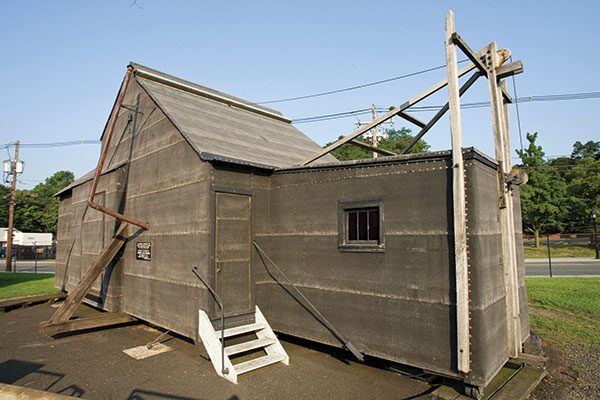
Behind a brick archway on a West Orange corner, Thomas Edison came to invent. In fact, about half of Edison’s 1,093 patents were based on experiments here, including his work with motion pictures and his improvements to the phonograph. The West Orange lab has been under renovation for the past five years but is due to reopen the weekend of October 10-12, providing the best opportunity yet to get to know New Jersey’s own father of modern technology.
Maintained by the National Park Service, the campus-like compound is where the Wizard of Menlo Park relocated his work in 1887 (and built a space ten times larger than his previous lab). Like much of what Edison achieved, the complex itself was revolutionary: It was one of the first research and development labs, at one time filled with 10,000 employees from around the world. Edison had his researchers work in teams—as opposed to the lonely scientist we may imagine—and his concept of taking an invention from idea to distribution in one place was unique.
Today, a visit to the lab complex is better than ever: The $13 million renovation was intended to preserve the collection and make it more accessible. The top two floors of the main lab building are now part of the experience, and more of the collection is on view. Before, 45-minute guided tours were the only way to experience the complex. Now, visitors can explore via audio tours, featuring oral histories of former employees (in four different languages), or a family tour for younger visitors. You can follow the audio tour’s path or choose your own, pushing an “in-depth” button for additional information at any given stop, and lingering when you find something especially intriguing.
And you will be tempted to linger. The volume of material is impressive: 400,000 artifacts, 5 million documents, 48,000 sound recordings, 10,000 rare books, 3,000 lab notebooks, and 60,000 photographs. The place to start is the visitor center (formerly the physics lab) for a brief orientation video. Then head to the main lab building, walking past the very clock where Edison punched in. To the right is the dramatic three-story library, a highlight of the tour. Here, employees researched projects and Edison entertained visitors amidst his many awards and honors. You might notice a cot that Edison’s second-wife, Mina, installed in the library for nights when the man who preached “there is no substitute for hard work,” never punched out.
The first floor holds the machine shop and stock room, with artifacts from all over the world—tools and parts, plus turtle shells, elephant hide, and other oddities. On the newly opened second and third floors, you will find the precision machine shop, Room 12 (Edison’s private lab, where he would retreat from time to time), the drafting room, the music recording studio, the photo lab, a gallery of phonographs (including the first one, where Edison famously recorded “Mary Had a Little Lamb”), and some of Edison’s later projects.
Across from the lab building are separate labs for chemistry and metallurgy and the pattern shop. Behind the visitor center is the Black Maria, the austere rotating shed that served as the world’s first motion picture studio.
After touring the lab complex, head over to Glenmont, Edison’s circa-1880 country home in Llewellyn Park—a gated community of “country homes for city people,” just a short drive from the lab complex. (Get your pass at the visitor center; it’s free with your entrance fee.) The 29-room Queen Anne-style home is furnished in the manner of the time—plus, of course, a phonograph here or motion picture machine there.
This was mostly Mina’s domain, where she raised their three children. (Edison also had three children from his first wife, Mary Stilwell.) Visit Edison’s office overlooking the yard, where he would play parcheesi and change the rules when he started to lose. Don’t miss a stop in the garage to see the 1922 Model-T that Henry Ford gave him, plus a 1912 Locomobile. If the lab reveals Edison the inventor, Glenmont illuminates Edison the man, the husband, the father. He and Mina are interned here.
Even 78 years after Edison’s death, the vibes here are galvanizing, giving us a final lesson from the man whose credo was: be courageous; try everything until something works; and dedicate yourself to your passion, trusting that “what you are will show in what you do.” And, it seems, in what you leave behind.
Thomas Edison National Historical Park is located at 211 Main Street, West Orange. Information: 973-736-0550, nps.gov/edis.
Click on the links below to read our Fall Day Trips stories:
Take A Hike: Aching feet and burning quads are a small price to pay for a trek on New Jersey’s Appalachian Trail.
Shudder And Quake: From fright fests to haunted hayrides, ghostly attraction abound in NJ.
Patriots Chilled: Tour the grounds where Washington’s (shivering) army slept.
Paterson Great Falls Historical Park
Rise To The Challenge: Tour New Jersey’s Historic Lighthouses.
Forging Ties: Batsto Village in Burlington County is a many-layerd Jersey pleasure.
Golden Golf: Don’t even think about putting away your clubs this month, New Jersey courses beckon.
